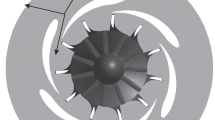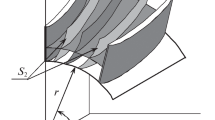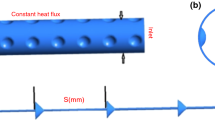Abstract
Finite volume methods were used to study the process of gas expansion in the stage of a turboexpander unit (TEU) in a three-dimensional, nonstationary setting. The main objectives of the work are to verify the calculation methodology based on a real experiment, to obtain a qualitative and quantitative agreement of data for further studies of the processes occurring in the flow path of the stage of a turboexpander unit, namely, phase transitions during condensation of impurities in the bulk. Due to the fact that the experiment is only preliminary tests, there is no reliable data on the intermediate values of the macroparameters; therefore, the verification of the proposed method was carried out only in terms of the temperature at the outlet from the diffuser and the isentropic efficiency. The calculation technique used in this work, thanks to the use of sliding interfaces, made it possible to study the turboexpander unit not in parts but with the help of a unified calculation model, taking into account the leaks and overflows of the working fluid (helium). In the course of calculations, the fields of velocity, pressure, and temperature were obtained in the longitudinal and cross sections of the turboexpander unit as well as on its walls. A simplified h, s-process diagram, and the values of isentropic efficiency are determined for several points. The proposed calculation method, applied for a specific model of a turboexpander unit, can be extrapolated to other variants of the flow paths of microturbine expander units for boundary conditions and operating modes close to the original variant. To prepare an extended calculation method, it is necessary to carry out additional studies as well as to establish the limits of applicability of the finite volume method on a larger data set.







Similar content being viewed by others
REFERENCES
L. D. Landau and E. M. Lifshits, Course of Theoretical Physics, Vol. 6: Fluid Mechanics (Fizmatlit, Moscow, 2015; Pergamon, Oxford, 2010).
Fluent Theory Guide 14 (ANSYS, 2011). https://www. ansys.com/products/fluids/ansys-fluent
O. Redlich and J. N. S. Kwong, “On the thermodynamics of solutions. V. An equation of state. Fugacities of gaseous solutions,” Chem. Rev. 44, 233–244 (1949). https://doi.org/10.1021/cr60137a013
D. C. Wilcox, “Formulation of the k-ω turbulence model revisited,” AIAA J. 46, 2823–2838 (2007). https://doi.org/10.2514/1.36541
V. V. Sychev, A. A. Vasserman, F. D. Kozlov, G. A. Spiridonov, and V. A. Tsymarnyi, Thermodynamic Properties of Helium (Izd. Standartov, Moscow, 1984) [in Russian].
R. Verma, R. V. Ashish, and A. S. Parthasarathi, “CFD analysis of turbo expander for cryogenic refrigeration and liquefaction cycles,” Phys. Procedia 67, 373–378 (2015). https://doi.org/10.1016/j.phpro.2015.06.043
A. B. Fetisov and E. N. Smirnov, “The efficiency influence of warm gas boost into the flowing channel of a cryogenic turbo-expander,” Tekh. Gazy, No. 5, 56–58 (2010). https://doi.org/10.18198/j.ind.gases.2010.0522
A. B. Davydov, A. Sh. Kobulashvili, and A. N. Sherstyuk, Calculation and Design of Turboexpander Engines (Mashinostroenie, Moscow, 1987) [in Russian].
L. E. Sternin, Fundamentals of Gasdynamics of Two-Phase Nozzle Flows (Mashinostroenie, Moscow, 1974) [in Russian].
A. A. Sidorov and A. K. Yastrebov, “Effect of channel geometry and properties of a vapor–gas mixture on volume condensation in a flow through a nozzle,” Therm. Eng. 65, 57–64 (2018). https://doi.org/10.1134/S0040601518010068
Funding
This study was financially supported by the Russian Foundation for Basic Research (project no. 19-38-90247).
Author information
Authors and Affiliations
Corresponding author
Rights and permissions
About this article
Cite this article
Sidorov, A.A., Yastrebov, A.K. Numerical Simulation of the Gas Expansion Process in a Turboexpander Unit by the Finite Volume Method. Therm. Eng. 68, 604–611 (2021). https://doi.org/10.1134/S0040601521070089
Received:
Revised:
Accepted:
Published:
Issue Date:
DOI: https://doi.org/10.1134/S0040601521070089




